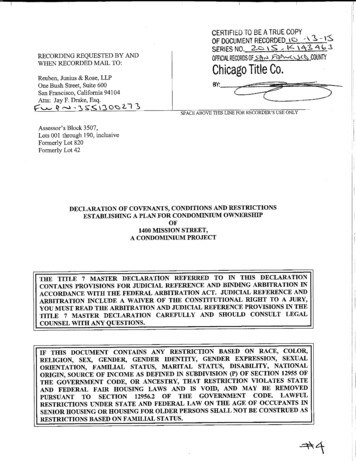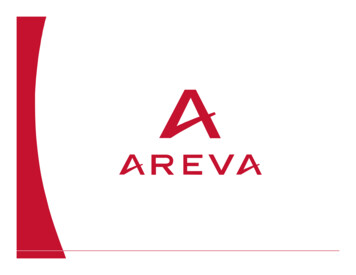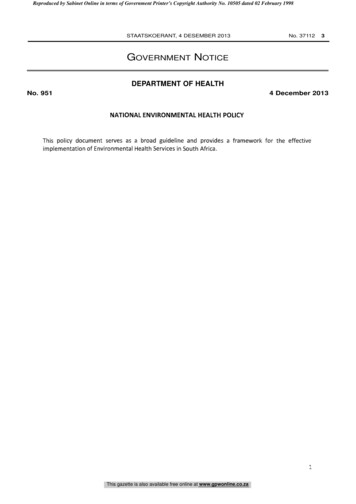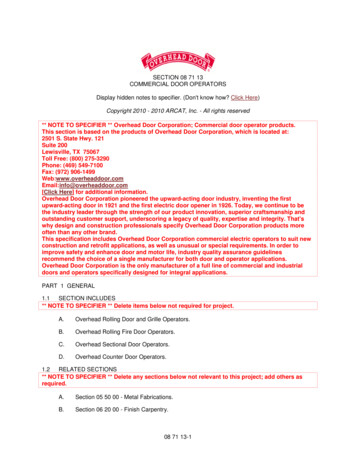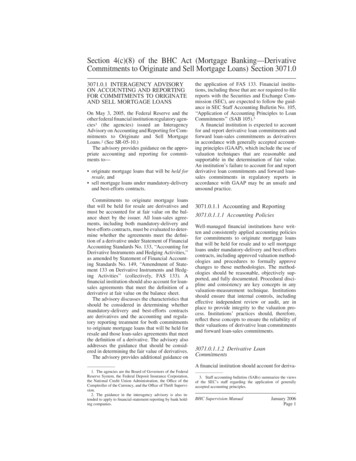
Transcription
Section 4(c)(8) of the BHC Act (Mortgage Banking—DerivativeCommitments to Originate and Sell Mortgage Loans) Section 3071.03071.0.1 INTERAGENCY ADVISORYON ACCOUNTING AND REPORTINGFOR COMMITMENTS TO ORIGINATEAND SELL MORTGAGE LOANSOn May 3, 2005, the Federal Reserve and theother federal financial institution regulatory agencies1 (the agencies) issued an InteragencyAdvisory on Accounting and Reporting for Commitments to Originate and Sell MortgageLoans.2 (See SR-05-10.)The advisory provides guidance on the appropriate accounting and reporting for commitments to— originate mortgage loans that will be held forresale, and sell mortgage loans under mandatory-deliveryand best-efforts contracts.Commitments to originate mortgage loansthat will be held for resale are derivatives andmust be accounted for at fair value on the balance sheet by the issuer. All loan-sales agreements, including both mandatory-delivery andbest-efforts contracts, must be evaluated to determine whether the agreements meet the definition of a derivative under Statement of FinancialAccounting Standards No. 133, ‘‘Accounting forDerivative Instruments and Hedging Activities,’’as amended by Statement of Financial Accounting Standards No. 149, ‘‘Amendment of Statement 133 on Derivative Instruments and Hedging Activities’’ (collectively, FAS 133). Afinancial institution should also account for loansales agreements that meet the definition of aderivative at fair value on the balance sheet.The advisory discusses the characteristics thatshould be considered in determining whethermandatory-delivery and best-efforts contractsare derivatives and the accounting and regulatory reporting treatment for both commitmentsto originate mortgage loans that will be held forresale and those loan-sales agreements that meetthe definition of a derivative. The advisory alsoaddresses the guidance that should be considered in determining the fair value of derivatives.The advisory provides additional guidance onthe application of FAS 133. Financial institutions, including those that are not required to filereports with the Securities and Exchange Commission (SEC), are expected to follow the guidance in SEC Staff Accounting Bulletin No. 105,‘‘Application of Accounting Principles to LoanCommitments’’ (SAB 105).3A financial institution is expected to accountfor and report derivative loan commitments andforward loan-sales commitments as derivativesin accordance with generally accepted accounting principles (GAAP), which include the use ofvaluation techniques that are reasonable andsupportable in the determination of fair value.An institution’s failure to account for and reportderivative loan commitments and forward loansales commitments in regulatory reports inaccordance with GAAP may be an unsafe andunsound practice.3071.0.1.1 Accounting and Reporting3071.0.1.1.1 Accounting PoliciesWell-managed financial institutions have written and consistently applied accounting policiesfor commitments to originate mortgage loansthat will be held for resale and to sell mortgageloans under mandatory-delivery and best-effortscontracts, including approved valuation methodologies and procedures to formally approvechanges to those methodologies. The methodologies should be reasonable, objectively supported, and fully documented. Procedural discipline and consistency are key concepts in anyvaluation-measurement technique. Institutionsshould ensure that internal controls, includingeffective independent review or audit, are inplace to provide integrity to the valuation process. Institutions’ practices should, therefore,reflect these concepts to ensure the reliability oftheir valuations of derivative loan commitmentsand forward loan-sales commitments.3071.0.1.1.2 Derivative LoanCommitmentsA financial institution should account for deriva-1. The agencies are the Board of Governors of the FederalReserve System, the Federal Deposit Insurance Corporation,the National Credit Union Administration, the Office of theComptroller of the Currency, and the Office of Thrift Supervision.2. The guidance in the interagency advisory is also intended to apply to financial-statement reporting by bank holding companies.3. Staff accounting bulletins (SABs) summarize the viewsof the SEC’s staff regarding the application of generallyaccepted accounting principles.BHC Supervision ManualJanuary 2006Page 1
Mortgage Banking—Derivative Commitments to Originate and Sell Mortgage Loanstive loan commitments at fair value on the balance sheet, regardless of the manner in whichthe intended sale of the mortgage loans will beexecuted (e.g., under a best-efforts contract, amandatory-delivery contract, or the institution’sown securitization). An institution should reporteach fixed, adjustable, and floating derivativeloan commitment as an ‘‘other asset’’ or an‘‘other liability’’ in their regulatory reports basedupon whether the individual commitment has apositive (asset) or negative (liability) fair value.4With respect to floating derivative loan commitments, because the interest rate on such acommitment ‘‘floats’’ on a daily basis with market interest rates, the fair value of a floatingderivative loan commitment approximates zeroas long as the creditworthiness of the borrowerhas not changed. However, as with other derivative loan commitments, an institution must reportthe entire gross notional amount of floatingderivative loan commitments in its regulatoryreports.Commitments to originate mortgage loansthat will be held for investment purposes andcommitments to originate other types of loansare not within the scope of FAS 133 and, therefore, are not accounted for as derivatives.5 Aninstitution should report the unused portion ofthese types of commitments, which are not considered derivatives, as ‘‘unused commitments’’in its regulatory reports.3071.0.1.1.3 Forward Loan-SalesCommitmentsA financial institution should account for forward loan-sales commitments for mortgage loansas derivatives at fair value on the balance sheet.Each forward loan-sales commitment should bereported as an ‘‘other asset’’ or an ‘‘other liability’’ based upon whether the individual commitment has a positive (asset) or negative (liability)fair value.64. When preparing Reports of Condition and Income (CallReports) and the Consolidated Financial Statements for BankHolding Companies (BHC reports), fixed, adjustable, andfloating derivative loan commitments should not be reportedas unused commitments in Schedule RC-L, Derivatives andOff-Balance Sheet Items (Schedule HC-1 for bank holdingcompanies), because such commitments are to be reported asderivatives in this schedule.5. See FAS 133, paragraph 10(i).6. Regardless of whether the underlying mortgage loanswill be held for investment or for resale, commitments topurchase mortgage loans from third parties under eitherBHC Supervision ManualPage 2January 20063071.03071.0.1.1.4 Netting of ContractsFor balance-sheet-presentation purposes, FAS133 does not provide specific guidance onfinancial-statement presentation.7 A financialinstitution may not offset derivatives with negative fair values (liabilities) against those withpositive fair values (assets), unless the criteriafor ‘‘netting’’ under GAAP have been satisfied.8 In addition, an institution may not offsetthe fair value of forward loan-sales commitments against the fair value of derivative loancommitments (the pipeline) or mortgage loansheld for sale (warehouse loans). Rather, forwardloan-sales commitments must be accounted forseparately at fair value, and warehouse loansmust be accounted for at the lower of cost or fairvalue (commonly referred to as ‘‘LOCOM’’)9with certain adjustments to the cost basis of theloans if hedge accounting is applied.3071.0.1.1.5 Hedge AccountingA financial institution should follow the guidance in FAS 133 when applying hedge accounting to its mortgage banking activities. If theFAS 133 qualifying criteria are met, an institution may apply— fair-value hedge accounting in a hedgingrelationship between forward loan-sales commitments (the hedging instrument) and fixedrate warehouse loans (the hedged item), or cash-flow hedge accounting in a hedgingrelationship between forward loan-sales commandatory-delivery contracts or best-efforts contracts arederivatives if, upon evaluation, the contracts meet the definition of a derivative under FAS 133. An institution shouldreport its loan-purchase commitments that meet the definitionof a derivative at fair value on the balance sheet.7. That is, FAS 133 does not provide specific guidancewhere, in the financial statements, the fair value of derivativesor the changes in the fair value of derivatives should beclassified and presented on the financial statement.8. When an institution has two (or more) derivatives withthe same counterparty, contracts with positive fair values andnegative fair values may be netted if the conditions set forth inFASB Interpretation No. 39, ‘‘Offsetting of Amounts Relatedto Certain Contracts’’ (FIN 39), are met. Those conditions areas follows: (1) each of the parties owes the other determinableamounts; (2) the reporting party has the right to set off theamount owed with the amount owed by the other party;(3) the reporting party intends to set off; and (4) the right ofsetoff is enforceable at law. In addition, without regard to thethird condition, fair-value amounts recognized for derivativecontracts executed with the same counterparty under a masternetting arrangement may be offset.9. See Statement of Financial Accounting Standards No.65, ‘‘Accounting for Certain Mortgage Banking Activities’’(FAS 65), paragraph 4.
Mortgage Banking—Derivative Commitments to Originate and Sell Mortgage Loansmitments (the hedging instrument) and theforecasted sale of the warehouse loans and/orthe loans to be originated under ).10If a financial institution does not apply hedgeaccounting, either because the FAS 133 hedgecriteria are not met or the institution chooses notto apply hedge accounting, forward loan-salescommitments should be treated as nonhedgingderivatives. If hedge accounting is not applied,an institution will account for its warehouseloans at the lower of cost or fair value. Becausenonhedging forward loan-sales commitmentsare accounted for at fair value through earnings,such an approach causes volatility in reportedearnings if the fair value of the warehouse loansincreases above their cost basis. In this situation, the volatility is a result of recognizing thefull amount of any decline in the fair value ofthe forward loan-sales commitments in earningswhile not adjusting the carrying amount of thewarehouse loans above their cost basis.3071.0.1.1.6 Income-Statement EffectUnless cash-flow hedge accounting is applied, afinancial institution should include the periodicchanges in the fair value of derivative loancommitments and forward loan-sales commitments in current-period earnings. An institutionshould report these changes in fair value ineither ‘‘other non-interest income’’ or ‘‘othernon-interest expense,’’ but not as trading revenue, in their regulatory reports. However, aninstitution’s decision as to whether to report thechanges in fair value in its regulatory reports inan income or expense line item should be consistent with its presentation of these changes inits general-purpose external financial statements(including audited financial statements)11 andshould be consistent from period to period.3071.0.1.2 Valuation3071.0.1.2.1 Fair ValueFAS 133 indicates that the guidance in Statement of Financial Accounting Standards No.107, ‘‘Disclosures About Fair Value of Financial Instruments’’ (FAS 107), should be fol10. See FAS 133, paragraphs 20–21, and related FAS 133guidance for hedging instruments, hedged items, and forecasted transactions that qualify for fair-value and cash-flowhedge accounting.11. See footnote 7.3071.0lowed in determining the fair value of derivatives.12 That guidance provides that quoted marketprices are the best evidence of the fair value offinancial instruments. However, when quotedmarket prices are not available, which is typically the case for derivative loan commitmentsand forward loan-sales commitments, estimatesof fair value should be based on the best information available in the circumstances (e.g., valuation techniques based on estimated expectedfuture cash flows). When expected future cashflows are used, they should be the institution’sbest estimate based on reasonable and supportable assumptions and projections.Estimates of fair value should consider pricesfor similar assets or similar liabilities and theresults of valuation techniques to the extentavailable in the circumstances. In the absence of(1) quoted market prices in an active market,(2) observable prices of other current markettransactions, or (3) other observable data supporting a valuation technique, the transactionprice represents the best information availablewith which to estimate fair value at the inception of an arrangement.A financial institution should not recognizean unrealized gain or loss at inception of aderivative instrument unless the fair value ofthat instrument is obtained from a quoted market price in an active market or is otherwiseevidenced by comparison to other observablecurrent market transactions or based on a valuation technique incorporating observable marketdata.13 Based on this guidance, derivative loancommitments generally would have a zero fairvalue at inception.14 However, subsequentchanges in the fair value of a derivative loancommitment must be recognized in financialstatements and regulatory reports (e.g., changesin fair value attributable to changes in marketinterest rates).When estimating the fair value of derivativeloan commitments and those best-efforts contracts that meet the definition of a derivative, a12. See FAS 133, paragraph 17.13. See footnote 3 in Emerging Issues Task Force IssueNo. 02-3 (EITF 02-3), ‘‘Issues Involved in Accounting forDerivative Contracts Held for Trading Purposes and ContractsInvolved in Energy Trading and Risk Management Activities.’’14. If a potential borrower pays the lender a fee uponentering into a derivative loan commitment (e.g., a rate-lockfee), there is a transaction price, and the lender should recognize the derivative loan commitment as a liability at inceptionusing an amount equal to the fee charged to the potentialborrower.BHC Supervision ManualJanuary 2006Page 3
Mortgage Banking—Derivative Commitments to Originate and Sell Mortgage Loans3071.0financial institution should consider predicted‘‘pull-through’’ (or, conversely, ‘‘fallout’’) rates.A pull-through rate is the probability that aderivative loan commitment will ultimately resultin an originated loan. Some factors that may beconsidered in arriving at appropriate pullthrough rates include (but are not limited to) theorigination channel (which may be either internal [retail] or external [wholesale or correspondent, to the extent the institution rather than thecorrespondent closes the loan]),15 current mortgage interest rates in the market versus theinterest rate incorporated in the derivative loancommitment, the purpose of the mortgage (purchase versus refinancing), the stage of completion of the underlying application and underwriting process, and the time remaining until theexpiration of the derivative loan commitment.Estimates of pull-through rates should be basedon historical information for each type of loanproduct adjusted for potential changes in marketinterest rates that may affect the percentage ofloans that will close. An institution should notconsider the pull-through rate when reportingthe notional amount of derivative loan commitments in regulatory reports but, rather, mustreport the entire gross notional amount.Further, no other internally developed intangibleassets (such as customer-relationship intangibleassets) should be recognized as part of derivative loan commitments. Recognition of suchassets would only be appropriate in a third-partytransaction (for example, the purchase of aderivative loan commitment either individually,in a portfolio, or in a business combination).3071.0.1.2.2 SAB 105Financial institutions should follow AccountingPrinciples Board Opinion No. 20 (APB 20),‘‘Accounting Changes,’’17 if a change in theiraccounting for derivative loan commitments,best-efforts contracts, or mandatory-delivery contracts is necessary. APB 20 defines various typesof accounting changes and addresses the reporting of corrections of errors in previously issuedfinancial statements. APB 20 states, ‘‘Errors infinancial statements result from mathematicalmistakes, mistakes in the application of accounting principles, or oversight or misuse of factsthat existed at the time the financial statementswere prepared.’’For regulatory reporting purposes, a financialinstitution must determine whether the reasonfor a change in its accounting meets the APB 20definition of an accounting error. If the reasonfor the change meets this definition, the errorshould be reported as a prior-period adjustmentif the amount is material. Otherwise, the effectof the correction of the error should be reportedin current earnings.If the effect of the correction of the error isIn March 2004, the SEC issued SAB 105 toprovide guidance on the proper accounting anddisclosures for derivative loan commitments.SAB 105 is effective for derivative loan commitments entered into after March 31, 2004.SAB 105 indicates that the expected future cashflows related to the associated servicing of loansshould not be considered in recognizing derivative loan commitments. Incorporating expectedfuture cash flows related to the associated servicing of the loan essentially results in theimmediate recognition of a servicing asset. Servicing assets should only be recognized whenthe servicing asset has been contractually separated from the underlying loan by sale or securitization of the loan with servicing retained.1615. If an institution commits to purchase a loan that will beclosed by a correspondent in the correspondent’s name, theinstitution would have a loan-purchase commitment ratherthan a derivative loan commitment. See footnote 6.16. See Statement of Financial Accounting Standards No.140 (FAS 140), ‘‘Accounting for Transfers and Servicing ofFinancial Assets and Extinguishments of Liabilities,’’ paragraph 61.BHC Supervision ManualPage 4January 20063071.0.1.3 Standard-Setter ActivitiesFinancial institutions should be aware that theSEC or the Financial Accounting StandardsBoard (FASB) may issue additional fair-value,measurement, or recognition guidance in thefuture (e.g., a fair-value measurement statement). To the extent that additional guidance isissued, institutions must also consider the guidance in developing fair-value-estimate methodologies for derivative loan commitments andforward loan-sales commitments as well as measuring and recognizing such derivatives.3071.0.1.4 Changes in Accounting forDerivative Loan Commitments andLoan-Sales Agreements17. Effective December 15, 2005, APB 20 will be replacedby FASB Statement No. 154, ‘‘Accounting Changes and ErrorCorrections—A Replacement of APB Opinion No. 20 andFASB Statement No. 3.’’
Mortgage Banking—Derivative Commitments to Originate and Sell Mortgage Loans3071.0material, a financial institution should also consult with its primary federal regulatory agencyto determine whether any of its prior regulatoryreports should be amended. If amended regulatory reports are not required, the institutionshould report the effect of the correction of theerror on prior years’ earnings, net of applicabletaxes, as an adjustment to the previously reportedbeginning balance of equity capital. For the CallReport, the institution should report the amountof the adjustment in Schedule RI-A, item 2,‘‘Restatements due to corrections of materialaccounting errors and changes in accountingprinciples,’’ with an explanation in ScheduleRI-E, item 4.The effect of the correction of the error onincome and expenses since the beginning of theyear in which the error is corrected should bereflected in each affected income and expenseaccount on a year-to-date basis beginning in thenext quarterly income statement (Call Report) tobe filed and not as a direct adjustment to retainedearnings. ‘‘lock in’’ the current market rate for a fixedrate loan (i.e., a fixed derivative loancommitment), ‘‘lock in’’ the current market rate for anadjustable-rate loan that has a specified formula for determining when and how the interest rate will adjust (i.e., an adjustable derivative loan commitment), or wait until a future date to set the interest rateand allow the interest rate to ‘‘float’’ withmarket interest rates until the rate is set (i.e., afloating derivative loan commitment).3071.0.1.5 Definitions of Terms Used inthe AdvisoryThe term forward loan-sales commitment refersto either (1) a mandatory-delivery contract or(2) a best-efforts contract that, upon evaluationunder FAS 133, meets the definition of aderivative.3071.0.1.5.1 Derivative LoanCommitmentThe term derivative loan commitment refers to alender’s commitment to originate a mortgageloan that will be held for resale. Notwithstanding the characteristics of a derivative set forth inFAS 133, these commitments to originate mortgage loans must be accounted for as derivativesby the issuer under FAS 133 and include, butare not limited to, those commonly referred toas interest-rate-lock commitments.In a derivative loan commitment, the lenderagrees to extend credit to a borrower undercertain specified terms and conditions in whichthe interest rate and the maximum amount of theloan18 are set prior to or at funding. Under theagreement, the lender commits to lend funds toa potential borrower (subject to the lender’sapproval of the loan) on a fixed- or adjustablerate basis, regardless of whether interest rateschange in the market, or on a floating-rate basis.In a typical derivative loan commitment, theborrower can choose to—18. In accordance with the ‘‘Background Information andBasis for Conclusions’’ in Statement of Financial AccountingStandards No. 149 (FAS 149), the notional amount of aderivative loan commitment is the maximum amount of theborrowing. See FAS 149, paragraph A27.Derivative loan commitments vary in term andexpire after a specified time period (e.g., 60days after the commitment date). Additionally,derivative loan commitments generally do notbind the potential borrower to obtain the loan,nor do they guarantee that the lender will approvethe loan once the creditworthiness of the potential borrower has been determined.3071.0.1.5.2 Forward Loan-SalesCommitment3071.0.1.5.3 Mandatory-DeliveryContractA mandatory-delivery contract is a loan-salesagreement in which a financial institution commits to deliver a certain principal amount ofmortgage loans to an investor at a specifiedprice on or before a specified date. If the institution fails to deliver the amount of mortgagesnecessary to fulfill the commitment by the specified date, it is obligated to pay a ‘‘pair-off’’ fee,based on then-current market prices, to theinvestor to compensate the investor for the shortfall. Variance from the originally committedprincipal amount is usually permitted, but typically may not exceed 10 percent of the committed amount.All loan-sales agreements must be evaluatedto determine whether they meet the definition ofa derivative under FAS 133.19 A mandatory19. See FAS 133, paragraph 6, for the characteristics of afinancial instrument or other contract that meets the definitionof a derivative.BHC Supervision ManualJanuary 2006Page 5
Mortgage Banking—Derivative Commitments to Originate and Sell Mortgage Loansdelivery contract has a specified underlying (thecontractually specified price for the loans) andnotional amount (the committed loan-principalamount), and requires little or no initial netinvestment. Additionally, a mandatory-deliverycontract requires or permits net settlement or theequivalent thereof as the institution is obligatedunder the contract to either deliver mortgageloans or pay a pair-off fee (based on the thencurrent market prices) on any shortfall on thedelivery of the committed loan-principal amount.Since the option to pay a pair-off fee accomplishes net settlement, it is irrelevant as towhether the mortgage loans to be delivered areconsidered readily convertible to cash.20 Basedon these characteristics, a mandatory-deliverycontract meets the definition of a derivative atthe time an institution enters into the commitment.3071.0.1.5.4 Best-Efforts ContractThe term best-efforts contract refers to a loansales agreement in which a financial institutioncommits to deliver an individual mortgage loanof a specified principal amount and quality to aninvestor if the loan to the underlying borrowercloses. Generally, the price the investor will paythe seller for an individual loan is specified priorto the loan being funded (e.g., on the same daythe lender commits to lend funds to a potentialborrower). A best-efforts contract that has all ofthe following characteristics would meet thedefinition of a derivative: an underlying (e.g., the price the investor willpay the seller for an individual loan is specified in the contract) a notional amount (e.g., the contract specifiesthe principal amount of the loan as an exactdollar amount or as a principal range with adeterminable maximum amount)21 requires little or no initial net investment (e.g.,no fees are exchanged between the seller andinvestor upon entering into the agreement, ora fee that is similar to a premium on otheroption-type contracts is exchanged) requires or permits net settlement or the equiva20. See FAS 133, paragraph 57(c)(1), for a description ofcontracts that have terms that implicitly or explicitly requireor permit net settlement.21. The use of a maximum amount as the notional amountof a best-efforts contract is consistent with the loancommitment discussion in the ‘‘Background Information andBasis for Conclusions’’ in FAS 149. See FAS 149, paragraphA27.BHC Supervision ManualPage 6January 20063071.0lent thereof (for example, the seller is contractually obligated to either (1) deliver the loanto the investor if the loan closes or (2) pay apair-off fee, based on then-current marketprices, to the investor to compensate the investor if the loan closes and is not delivered.Since the option to pay a pair-off fee accomplishes net settlement, it is irrelevant as towhether the loan to be delivered is consideredreadily convertible to cash.).3071.0.1.5.5 Master AgreementA financial institution may enter into one ofseveral types of arrangements with an investorto govern the relationship between the institution and the investor and set the parametersunder which the institution will deliver individual mortgage loans through separate bestefforts contracts. Such an arrangement mightinclude, for example, a master agreement or anumbrella contract. These arrangements mayspecify an overall maximum principal amountof mortgage loans that the institution may deliverto the investor during a specified time period,but generally they do not specify the price theinvestor will pay for individual loans. Further,while these arrangements may include pair-offfee provisions for loans to be sold under individual best-efforts contracts covered by thearrangements, the seller is neither contractuallyobligated to deliver the amount of mortgagesnecessary to fulfill the maximum principal amountspecified in the arrangement nor required to paya pair-off fee on any shortfall. Because thesearrangements generally either do not have aspecified underlying or determinable notionalamount or do not require or permit net settlement or the equivalent thereof, the arrangementstypically do not meet the definition of a derivative. As discussed above, an individual bestefforts contract governed by one of thesearrangements may, however, meet the definitionof a derivative.As the terms of individual best-efforts contracts and master agreements or umbrella contracts vary, a financial institution must carefullyevaluate such contracts to determine whetherthe contracts meet the definition of a derivativein FAS 133.
Mortgage Banking—Derivative Commitments to Originate and Sell Mortgage Loans3071.0.1.6 Example of the Accountingfor Commitments to Originate and SellMortgage Loans223071.0.1.6.1 ABC Mortgage FinancialInstitution (Best-Efforts Contracts and NoApplication of Fair-Value HedgeAccounting)The following simplified example was developed to provide a financial institution that has alimited number of derivative loan commitmentsgeneral guidance on one approach that may beused to value such commitments.23 This example also illustrates the regulatory reportingrequirements for derivative loan commitmentsand forward loan-sales commitments.The guidance in this example is for illustrative purposes only, as there are several ways thata financial institution might estimate the fairvalue of its derivative loan commitments. Asecond approach to valuing derivative loan commitments is described in Derivative Loan Commitments Task Force Illustrative Disclosures onDerivative Loan Commitments, a practice aiddeveloped by staff of the American Institute ofCertified Public Accountants (AICPA) and atask force comprising representatives from thefinancial services, mortgage banking, and publicaccounting communities.24 As indicated in thebody of the interagency advisory, a financialinstitution must consider the guidance in FAS133, FAS 107, EITF 02-3, and SAB 105 inmeasuring and recognizing derivative loan commitments and forward loan-sales commitments.In addition, an institution should be aware thatthe SEC or FASB may issue additional guidancein the future that may alter certain aspects ofthis example.3071.0.1.6.1.1 BackgroundABC Mortgage Financial Institution (ABC) enters into fixed, adjustable, and floating deriva22. This
loans if hedge accounting is applied. 3071.0.1.1.5 Hedge Accounting A financial institution should follow the guid-ance in FAS 133 when applying hedge account-ing to its mortgage banking activities. If the FAS 133 qualifying criteria are met, an institu-tion may apply— fair-value hedge accounting in a hedging

